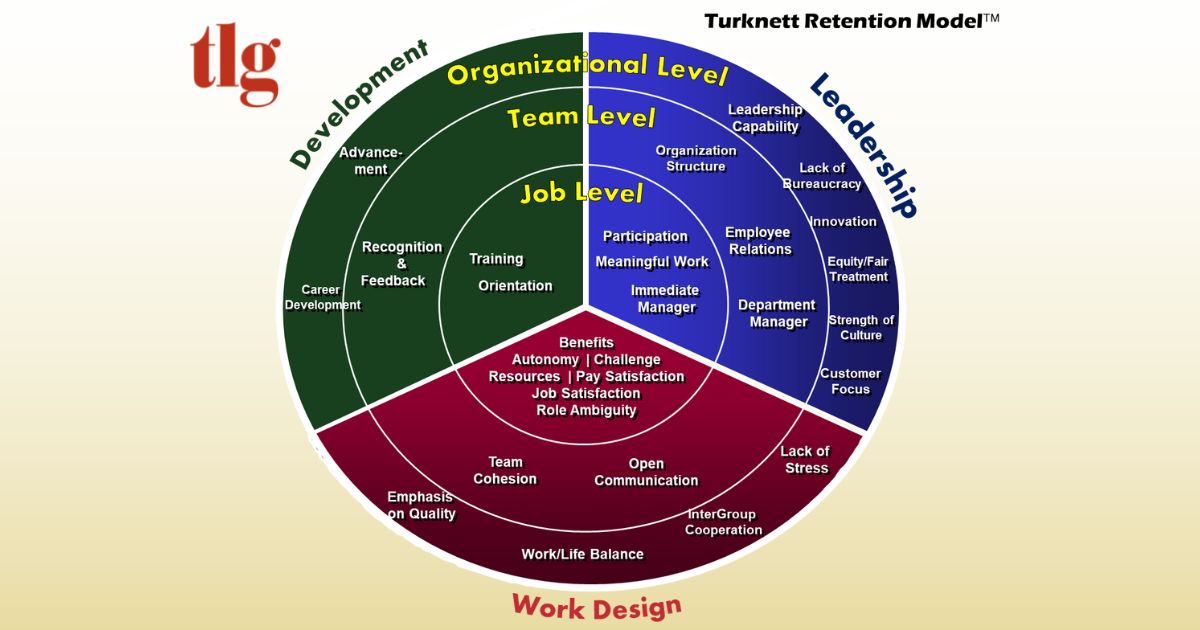
 By Lyn Turknett
By Lyn Turknett
Co-founder and Co-chair, TLG
About 25 years ago we had an experience that showed the shocking power of development opportunities. A super-talented, high-powered salesperson at a large telecom was about to leave. Her boss was frantic. Amazingly, it wasn’t a retention bonus that kept her, or a promise of a promotion. She had told someone that she wanted to do our Executive Development Program. Her boss offered her the opportunity with a very senior TLG consultant, and she stayed for several additional years.
She got the opportunity for development as a person and as a leader, and since that time, we’ve had plenty of experiences and seen lots of data that show how important development is in retaining every employee. Leadership development is doubly important – it helps the organization retain good leaders, and it addresses another key reason employees leave – bad leadership.
We did a deep dive into retention research in 2000. That was a time, like the recent past, when it was blisteringly difficult to hire and critical to retain employees. In that year, we hired a research assistant who was, under the guidance of an industrial and organizational psychologist, fully devoted to gathering all the academic and private research we could find on the subject of what keeps employees at all levels around. Based on that, we developed the Turknett Retention Model. The areas of importance, Development, Leadership, and Work Design, would hold up today, and are echoed in a recent article, Rethink Your Employee Value Proposition, by Mark Mortensen and Amy Edmundson in HBR.

The Benefits of Leadership Development
Growth and development are the lifeblood of any organization – they are the fuel for innovation and change, and they keep people excited, engaged, and committed. Daniel Pink’s 2011 book “Drive“ is still one of my favorites on human motivation, and the three motivating drives he identifies, Autonomy, Purpose, and Mastery (learning and development) still ring true. And this Drive “explainer video” remains excellent – monetary rewards don’t usually work as we expect. Leaders particularly need to know that!
Leadership Development packs a double punch – it helps retain talented leaders, and it helps leaders lead in ways that both grow and retain the work force. Roger Martin, one of my favorite thinkers, has an excellent recent article on helping leaders lead in ways that grow talent – and keep people learning. In the article entitled “Designing Jobs Right,” Martin describes how leaders can help keep people engaged and growing in the everyday course of project-based work. He tells the story of a strategy consulting firm he co-led that evaluated engagement managers on a regular basis using upward feedback from team members.
One person, Jan Rivkin, got ratings far, far higher than any other manager. It turned out that instead of assigning tasks, he sat down with each team member to discuss what parts of the project they’d like to do. And he did something else. He found that if he just let them pick, they might select things that were already easy for them. Through a collaborative conversation he helped find parts of the project that were at the “growing edge” of their competence – things that were just hard enough to be challenging, but not impossible. He also has a great suggestion in the article on “giving your boss a job in return.”
This summary of “why leadership development” from the Center for Creative Leadership in 2021 gives four great reasons to consider leadership development:
1. To improve bottom-line financial performance. 2. To attract, retain, and develop talent. 3. To drive strategy execution. 4. To increase success in navigating change.
Organizational success depends on leadership development.
When an Organization Lacks Leadership Development
There are many consequences that can result from a lack of leadership development– the main one being that the best leaders – and the best employees – leave without leadership development. A big problem is that organizations often fail to provide basic training for new managers. And they often promote into management people who were the best individual contributors. Those employees are often highly dependable and good at getting tasks done, but leadership is about working through others, and helping others succeed. Leadership requires another set of skills entirely.
Also, without help, many new leaders think that being a boss means being bossy, and they start behaving in ways that drive their new employees nuts. A friend of ours wrote a book to help new leaders learn to lead. It’s entitled “Be the Boss Everyone Wants to Work For: A Guide for New Leaders.” There’s also a well-reviewed book entitled “The First-Time Manager,” and Linda Hill has written extensively on the topic. At least give them a book!!

